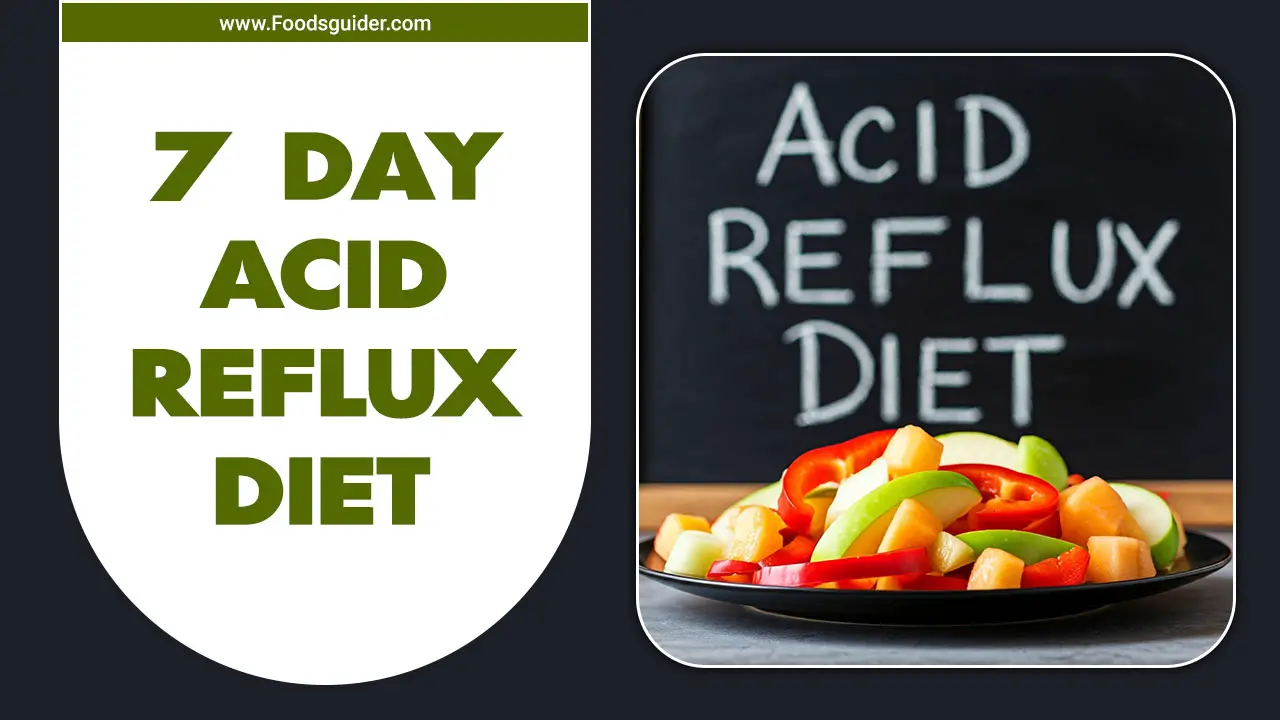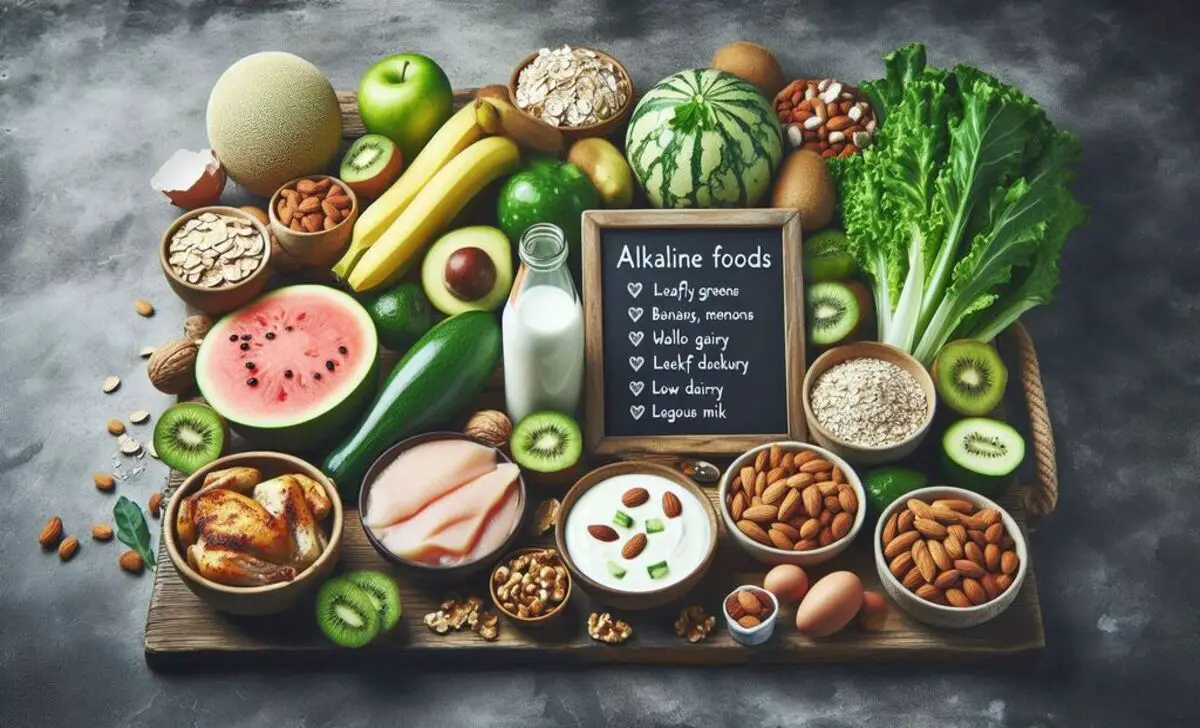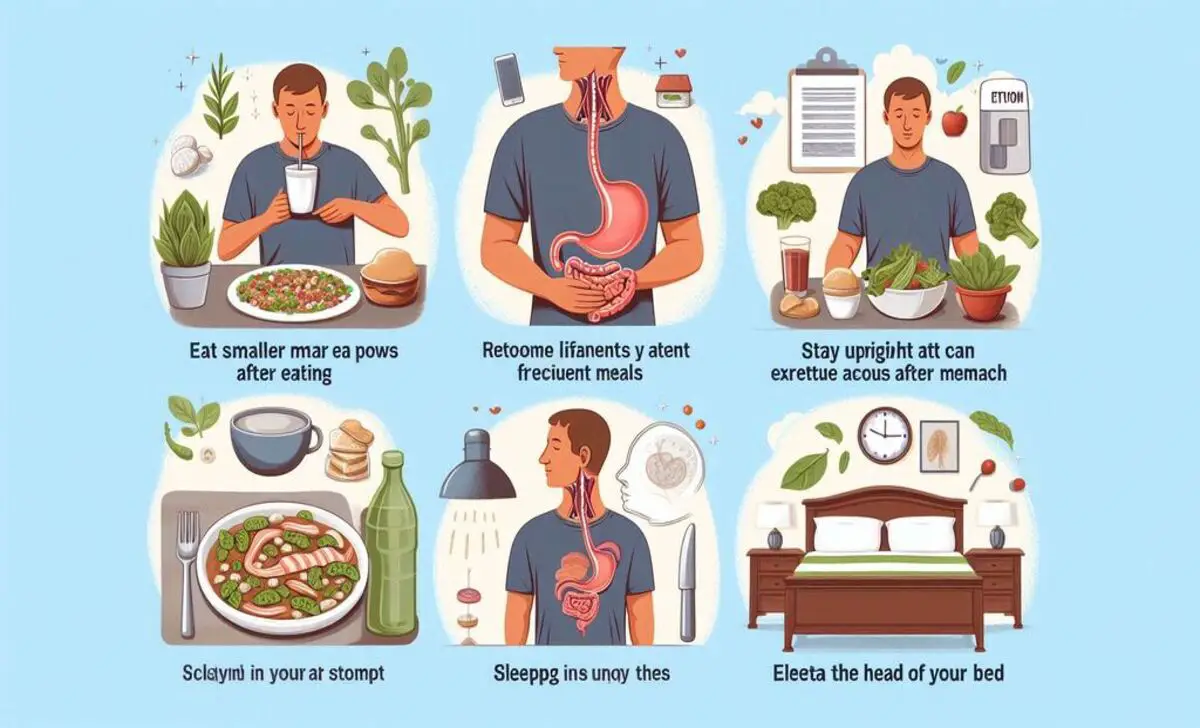Acid reflux, also known as gastroesophageal reflux disease (GERD), affects millions of people worldwide. This condition occurs when stomach acid flows back into the esophagus, leading to discomfort and a range of reflux symptoms, such as heartburn.
Managing acid reflux often requires dietary intervention. The 7 Day Acid Reflux Diet provides a structured meal plan aimed at reducing reflux episodes and alleviating symptoms. This article will explore the diet in detail, offering guidance on foods to enjoy and avoid, and will highlight lifestyle changes to complement your dietary efforts.

Common Reflux Symptoms
- Heartburn
- Regurgitation of food or sour liquid
- Difficulty swallowing
- Chronic cough
- Sore throat
- Hoarseness
If you’re experiencing these symptoms frequently, you may be suffering from gastroesophageal reflux disease. A GERD diet is often recommended to help manage symptoms effectively.
7 Day Acid Reflux Diet Day By Day

Acid reflux occurs when the lower esophageal sphincter (LES) weakens, allowing stomach contents to flow back into the esophagus. This leads to discomfort, often characterized by heartburn symptoms. The frequency and intensity of these reflux episodes can vary among individuals, making it crucial to identify trigger foods that may exacerbate the condition. Below is a sample meal plan for one week.
Day 1
- Breakfast: Oatmeal made with almond milk topped with sliced bananas.
- Snack: Greek yogurt with honey.
- Lunch: Grilled chicken breast with quinoa and steamed broccoli.
- Snack: Sliced apples with almond butter.
- Dinner: Baked salmon with brown rice and sautéed spinach.
Day 2
- Breakfast: Smoothie with spinach, almond milk, and a scoop of protein powder.
- Snack: Carrot sticks with hummus.
- Lunch: Turkey and avocado wrap using grain bread.
- Snack: Rice cakes with peanut butter.
- Dinner: Stir-fried tofu with mixed vegetables over brown rice.
Day 3
- Breakfast: Scrambled eggs with diced bell peppers.
- Snack: Handful of almonds.
- Lunch: Lentil soup with a slice of grain toast.
- Snack: Celery sticks with cream cheese.
- Dinner: Baked chicken thighs with sweet potatoes.
Day 4
- Breakfast: Smoothie bowl topped with berries and granola.
- Snack: Cucumber slices with vinegar.
- Lunch: Grilled shrimp with a mixed green salad.
- Snack: Greek yogurt with granola.
- Dinner: Vegetable stir-fry with quinoa.
Day 5
- Breakfast: Chia seed pudding with almond milk and honey.
- Snack: Banana with almond butter.
- Lunch: Quinoa salad with cucumbers, tomatoes, and feta cheese.
- Snack: Air-popped popcorn.
- Dinner: Baked cod with steamed asparagus.
Day 6
- Breakfast: Whole grain cereal with almond milk.
- Snack: Mixed berries.
- Lunch: Chicken Caesar salad with a light dressing.
- Snack: Sliced peaches.
- Dinner: Zucchini noodles with marinara sauce.
Day 7
- Breakfast: Whole grain toast with avocado.
- Snack: Low-fat cottage cheese with pineapple.
- Lunch: Black bean and corn salad.
- Snack: Baby carrots.
- Dinner: Grilled turkey burger wrapped in lettuce with sweet potato fries.
Foods To Include

- Alkaline Foods: Leafy greens, bananas, melons, oatmeal, and whole grains.
- Healthy Fats: Avocado, nuts, and olive oil.
- Low-Fat Dairy: Greek yogurt and almond milk.
- Lean Proteins: Chicken, turkey, fish, and legumes.
Foods To Avoid
- Acidic Foods: Citrus fruits, tomatoes, and vinegar.
- Fatty Foods: Fried items, fatty cuts of meat, and full-fat dairy.
- Spicy Foods: Chili peppers and hot sauces.
- Large Meals: Eating larger portions can increase stomach acid production and pressure on the LES.
Lifestyle Changes To Complement The Diet

Implementing lifestyle changes can further help in managing acid reflux. Here are some effective strategies:
- Eat Smaller Meals: Consuming smaller, more frequent meals can prevent excessive acid production and reduce pressure on the stomach.
- Stay Upright After Eating: Remaining upright for at least two hours after meals can minimize acid exposure in the esophagus.
- Elevate the Head of Your Bed: Sleeping with your head elevated can help prevent nighttime reflux.
- Maintain a Healthy Weight: Weight loss can reduce abdominal pressure, minimizing reflux symptoms.
Conclusion
The 7 Day Acid Reflux Diet serves as a practical approach to managing gastroesophageal reflux disease. By incorporating alkaline foods and making lifestyle changes, individuals can alleviate reflux symptoms and improve their quality of life. Consulting a registered dietitian can provide personalized guidance and support in implementing this diet effectively.
FAQs
1.Can The 7 Day Acid Reflux Diet Cure Acid Reflux?
While this diet can significantly reduce symptoms, it may not completely cure acid reflux. Long-term management strategies are often necessary.
2.What Foods Trigger Acid Reflux?
Common trigger foods include spicy foods, acidic foods (like citrus and tomatoes), fatty foods, and large meals.
3.Is Weight Loss Effective For Managing GERD?
Yes, weight loss can reduce abdominal pressure and help manage GERD symptoms.
4.How Does The Diet Affect Acid Production?
A diet high in alkaline foods can help neutralize stomach acid, reducing the likelihood of reflux episodes.
5.Should I Consult A Healthcare Professional Before Starting The Diet?
Yes, it’s advisable to consult a registered dietitian or healthcare professional for personalized advice and to ensure the diet meets your health needs.